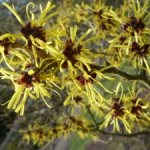Plant Blogs – Bio 117 – Witch Hazel
By Henry Finkelstein
Witch Hazel (Hamamelis ovalis)
Family: Hamamelidaceae
Photograph source: https://www.flickr.com/photos/hortoris/4348323081/
Identifying Traits:
- Classified as a shrub, Witch Hazel will rarely grow to the size of a small tree.
- The branches are quite pliable and can be bent without breaking.
- “Witch Hazel” is derived from the Old English word ‘Wych,’ meaning ‘to bend.’
- The leaves resemble those found on the Hazelnut Tree, hence the common name “Witch Hazel.”
- Witch Hazel produces flowers at the same time the previous year’s fruit matures.
Geographic Range:
Witch Hazel can be found within the United States in the Northeast and Southeast from the border with Ontario and Nova Scotia to the Florida Panhandle. Apart from being found on the Eastern Seaboard, Witch Hazel also extends westward from Texas up to Minnesota. It can be found in all of the thirty-five states within this wide geographic range.
Interesting Facts:
- Native Americans used Witch Hazel for medicinal purposes.
- Hamamelitannins and proanthocyanidins found in the Witch Hazel plant have anti-inflammatory properties, which have led to its use for certain treatments for ailments.
- There is still a market in the United States for over-the-counter Witch Hazel products to treat sores, bruises, and swelling. It functions as an external analgesic.
- Witch Hazel extract is a distillation of Witch Hazel twigs mixed with a small amount of alcohol.
- This can be applied to the affected areas on the body to relieve pain.
Other links about related species of Witch Hazel:
http://www.fs.fed.us/database/feis/plants/tree/hamvir/all.html
http://www.sierrapotomac.org/W_Needham/Witch_Hazel_041003.htm
http://www.stevenfoster.com/education/monograph/witchhazel.html
